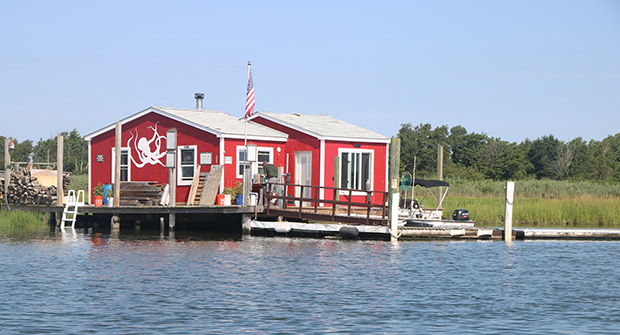A handful of little bay homes still dot the marshlands of Hempstead Bay, a holdover of the shacks that baymen built to be close to the water where they made their living starting as far back as the 1600s. These tiny homes have no electricity, no permanent foundations and are prone to floating away in exceptionally high tides. Once seen as a hazard to the wetlands, these curiosities became seen as an important part of Long Island history and promptly preserved by conservationists.
Below we have gathered some crazy and historical facts about Long Island bay homes.
- Bay houses are built on little islands within the marshland off the Sound Shore
- Bay houses can only be accessed by boat
- Starting in the 1700’s the Town of Hempstead leased land along the bay
- The first bay houses were built around 1680
- Fishermen, baymen and hunters built these small cottages on the marshland
- Most of the shacks were partly built with driftwood
- Houses have been said to be constructed with doors, telephone poles and parts of other structures like garages and demolished clapboard houses
- The houses stand on mud sills - poles laid on marshland with posts to support a platform that the house is built on top of
- There is no permanent foundation
- Many houses are built with trap doors that open to intentionally flood the house so the structure doesn’t float away if the water level rises during a storm

Photo: Long Island Traditions Facebook page.
- During Prohibition on Long Island, rum runners used the bay houses to store contraband that they were smuggling onto the mainland from ships out in the Atlantic
- Two locals were said to have stashed money from their booze haul in a cigar box in their bay house. When the money got wet during a high tide they tacked the money on the walls to dry. Federal marshals chose that monet to bust the pair but only found the gentlemen drying their cash with no hooch around the place. “Ain’t against the law to have money,” said one of the men to the officers who agreed and let them be
- It’s said that bay house owners made small fortunes as rum runners during Prohibition
- According to Long Island Traditions website in 1933, the Meadowbrook and Wantagh parkways were built on marshlands where many bay houses stood and many houses were moved or demolished
- Erosion also forced many homeowners to have to relocate their bay houses
- After WWII the Town of Hempstead encouraged bay house construction and granted permits to anyone who wanted to build one
- There were about 300 bay houses in Hempstead Bay by the 1960s
- After the passing of the Clean Water Act in 1965, the Town of Hempstead reversed its stand and had most of the bay houses removed to protect the wetlands
- Law decreed that any damaged home (greater than 20% damage) had to be removed
- All bay houses were set to be removed starting in 1993
- By the 1980s only 50 bay houses remained and no new houses were built
- Author and historic preservationist Nancy Solomon helped save the remaining bay houses
- Newsday called Solomon the bay houses’ guardian angel
- Solomon spied the bay houses on a boat ride and became interested in their history and preservation
- Initially bay house owners were suspicious of Solomon but came to embrace her and her cause
- Solomon authored a book titled, “On the Bay: Bay Houses and Maritime Culture on Long Island’s Marshlands”
- Solomon’s organization Long Island Traditions offers summertime bay house tours
- There is a documentary about Long Island Bay House that aired on PBS called “A World Within a World: The Bay Houses Of Long Island”

Photo: Long Island Traditions Facebook page.
- Numbers dwindled to about 30 bay houses in the Town of Hempstead
- In 1991 in another reversal due to Solomon’s advocacy the Town of Hempstead took action to preserve the remaining bay houses
- After Superstorm Sandy only 14 remained
- The bay houses that remain are considered eligible for listing on the National Register of Historic Places
- Bay houses cannot be bought or sold - only be transferred within a family or to a designated caretaker
- Many of the families that own bay houses are descendants of commercial baymen, fishermen and duck hunters who originally built the houses themselves
- Celebrated artist Daniel Pollera created oil paintings of bay houses
- You can watch a video about Pollera’s work here
- Pollera died in March 2022
- In addition to the Hempstead bay houses, in the Town of Islip on the Great South Bay there are about 40 additional bay houses on Captree, Havermeyer and Sexton Islands
- The video below shows Brian Warasila, a bay house owner, who describes the joys and challenges of owning a bay house by Long Island Traditions
Video: Long Island Traditions YouTube page.












